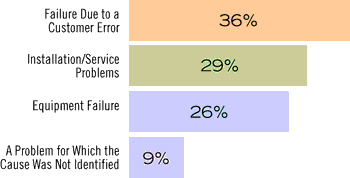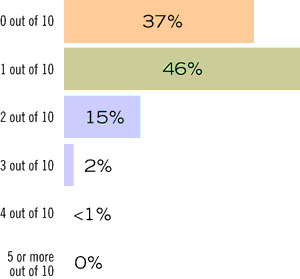
How familiar is this: A homeowner shops around for the lowest bid on a new central air or heat pump system. The equipment works initially, but the compressor wears out prematurely. The homeowner says he never changed the filter or performed other essential maintenance; he didn’t know he was supposed to.
Part of the low cost, however, is due to the fact that the installing contractor has lower overhead because his installers have not been properly trained in fundamentals, such as checking the refrigerant charge. The homeowner eventually calls you to fix or replace the unit.
This scenario falls in line with the results of The News’ “2001 Unitary Heating/Cooling Study.” The numbers give some insight into what is going on in the field.
More often than not, residential hvac contractors are called upon to service equipment they did not install, according to the survey’s results. The most common reason cited for failures is “customer error” (an average of 36%), with “installation/service problems” cited 29% of the time, and “equipment failure” cited 26% of the time. (See Figure 1.) Just over one-half (53%) of the contractors surveyed said they frequently service equipment they did not install.
Very few installations require callbacks for repair or service in the first month. (See Figure 2.) This would seem to indicate problems that take time to develop, such as those related to installation and/or lack of maintenance.
Nearly two-thirds of the residential contractors’ business is in replacement work, according to their responses. Residential and light commercial contractors expect service work to increase.

Quality, Price
On the residential side, 86% of the respondents said it is unlikely or very unlikely that they will change theirprimarybrand within the next 12 months. However, almost one-fourth said they would consider changing one of their brands. The top four reasons are better price, superior equipment (tied at 46%), better warranty (34%), and availability (34%).On the light commercial side, quality/reliability ranked highest (86%) among factors that are “very important” to contractors in brand purchase decisions. Durability, serviceability, and ease of installation were next in order of importance (72%, 68%, and 62%, respectively).
However, about two-thirds (65%) of these contractors said they would consider changing brands in the next two years. The top reason (57%) was “better price.” “Superior equipment” came in second at 45%.
In general, contractors seem to be developing a deep bench. While the number of contractors carrying one or two brands of equipment has remained relatively consistent since the 1995 unitary study, the number of contractors selling five or more brands of residential equipment has increased. Contractors seem to be leaning towards selling two or three brands in the future. (See Figure 3.)
Of the 46 manufacturers/brands listed in this survey, residential contractors predict an average of 31 of these will still be available in five years. Of the 52 light commercial manufacturers/brands, contractors predicted an average of 37 would still be available in five years.

Techs, Training
In comparison to the 1999 study, the average number of service technicians employed by residential contracting firms has increased slightly, from five in 1999 to six in 2001. The average number of installers has also increased, from six to seven. Thirty-seven percent of those responding employ five or more service technicians, and 42% said they employ five or more installers.In the light commercial market, the average number of service technicians employed by contracting firms has increased slightly, from six to seven, while the average number of installers has decreased from 11 to eight.
As far as their certification goes, 51% of the residential contractors said they have technicians certified by the Refrigeration Service Engineers Society (RSES), followed by 23% certified by North American Technician Excellence (NATE), and 9% by Air Conditioning Excellence (ACE). In 1999, the percentages were 83%, 15%, and 12%, respectively. Fifty-nine percent of light commercial contractors have technicians certified by RSES, 20% certified by NATE, and 9% by ACE.
Warranties
Most contractors, residential and light commercial, indicated that they prefer traditional warranties over extended warranties. However, when it comes to sales, you just can’t argue with results.On the residential side, just over one-half (51%) of the contractors said they prefer the traditional warranty: one year on parts, five years on the compressor. This figure is down 11% from 1999. However, two-thirds (68%) agree that extended warranties have helped them close on equipment.
Nearly half of the light commercial contractors also said they prefer the traditional warranty described above. Still, over two-thirds said they believe that extended warranties have helped them close on equipment sales.
METHODOLOGY: The sample population for the Unitary Study consisted of 4,000 randomly selected active contractors subscribing to The News. The response rate for the Residential Study was 18%, and 17% for the Light Commercial Study.
Publication date: 08/27/2001

Report Abusive Comment